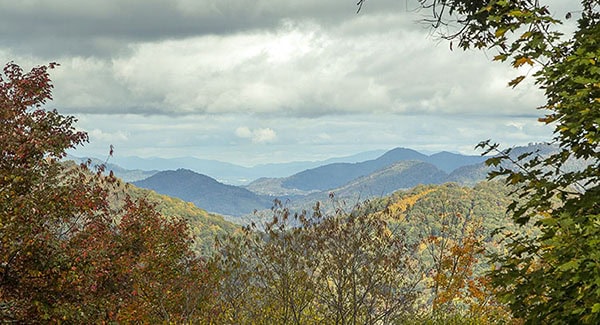
Last Updated on December 3, 2024
In 2002, the United Nations declared December 11 to be International Mountain Day. The unofficial holiday celebrates the importance of mountainous regions around the globe. Mountains are home to 15% of the world’s population and host nearly half of the world’s biodiversity hotspots.
Here in Western North Carolina, we take time every day to recognize the mountains we call home. They are the source of our fresh water, serve as a backdrop for all our favorite outdoor activities, and are home to some of the most unique critters on the planet. Celebrate our mountains with us today! Here are five things everyone should know about the mountains of Haywood County, NC.
1. Several mountain ranges run through the county
Haywood County covers 555 square miles and features nearly as many mountain ranges. We hyperbolize, but there is a lot going on, geologically speaking.
The Blue Ridge Mountains are the major range running through WNC, which are themselves a physiographic province of the larger Appalachian Mountains range. Haywood County contains parts of several major subranges of the Blue Ridge. The Great Smoky Mountains make up the west of the county. The Plott Balsams and Great Balsam Mountains can be found in the south. And the Nantahala Mountains rise nearby.
The county’s elevation also influences its freshwater. All rivers and springs in Haywood County originate on site—no water flows in from adjacent counties. The Pigeon River, one of the major rivers of the surrounding region, originates in Haywood County.
2. Haywood County mountains are closer to the sky!
Haywood County boasts the highest average elevation of any county east of the Rockies. In fact, the county is home to 18 mountains towering 6,000 feet or higher. Mt. Guyot is the county’s highest point at 6,621 feet (2,018 m) and is also the fourth highest mountain east of the Mississippi River. Black Balsam Knob (6,214 ft | 1,894 m) is the highest grassy bald in the entire Appalachian range. It is located in the Great Balsam Mountains in the southeastern section of the county. You can reach the highest elevations along the Blue Ridge Parkway from Haywood County, as well.
The ridges of Haywood County bring snow in the winter and cooler temperatures in the summer, qualities that have attracted tourists and residents for generations. Early doctors prescribed visits to patients suffering from respiratory ailments—not an unpleasant prescription, by any means. And hotels once treated those suffering from tuberculosis.
3. Much of the mountains are now protected as national parks and forests
Great Smoky Mountains National Park covers a large portion of northwest Haywood County, north of Maggie Valley. In fact, the county seat of Waynesville was once known as “the Gateway to the Smokies.” Parts of Pisgah National Forest lie in the far northeastern and southern parts of the county. And Nantahala National Forest is North Carolina’s largest national forest at 516,000 acres. It spans from Waynesville west, to Murphy, Fontana, and Cashiers. Tennessee’s Cherokee National Forest also borders Haywood County along its northern border.
Locals and visitors alike enjoy the natural beauty of the county. Adventures await along mountain biking trails and whitewater rafting rivers. Locals can explore trails their entire lives and still find something new.
4. Wildlife abounds in these mountains
The Cherokee were the first peoples known to inhabit the area now called Haywood County. Many members of the Eastern Band of Cherokee Indians (EBCI) still live within the Qualla Boundary, which encompasses parts of five WNC counties, including Haywood. However, the area has always been home to far more species of flora and fauna than people. Hundreds of species of mammals, fish, birds, reptiles, amphibians, trees, and flowering plants thrive here—a number of which are threatened or endangered.
The Cataloochee Valley remains a hotspot steeped in history, blanketed with wildflowers, and rich with wildlife. It’s a great place to see eye-catching critters of all sizes, including black bears, elk, salamanders, and white-tailed deer. Many species of birds, from cedar waxwings and indigo buntings to ruffed grouse and wild turkey can also be spotted in Cataloochee.
5. At least one mountain is famous!
If you’ve read Cold Mountain or seen the 2003 film, you’ve visited Haywood County (at least in spirit!). Based on a true family story of WNC native author Charles Frazier, this is the tale of William Pinkney Inman. He was a man conscripted into the Confederate army during the Civil War, but deserted to return to his love, Ada. Even though much of the film takes place in the Blue Ridge Mountains, around the true-life Cold Mountain, the film was primarily shot in Romania.
Today, hiking the mountain requires a map and an entire day. But you can view Cold Mountain by following U.S. 276 out of Waynesville until you hit the Blue Ridge Parkway. The Cold Mountain overlook is right at the U.S. 276/Blue Ridge Parkway intersection.
Make the mountains of Haywood County your home!
Haywood County consists of four unique mountain towns: Canton, Clyde, Maggie Valley, and Waynesville, as well as an assortment of unique mountain communities. Throughout the county, you will find an array of places and events that are of great significance. From musical events to art exhibits, Haywood County has active arts organizations that bring a variety of events to the area. Whatever your interests, there is something to look forward to every month of the year.
Does that sound like the perfect lifestyle for you? Find your perfect mountain home in Haywood County now!



